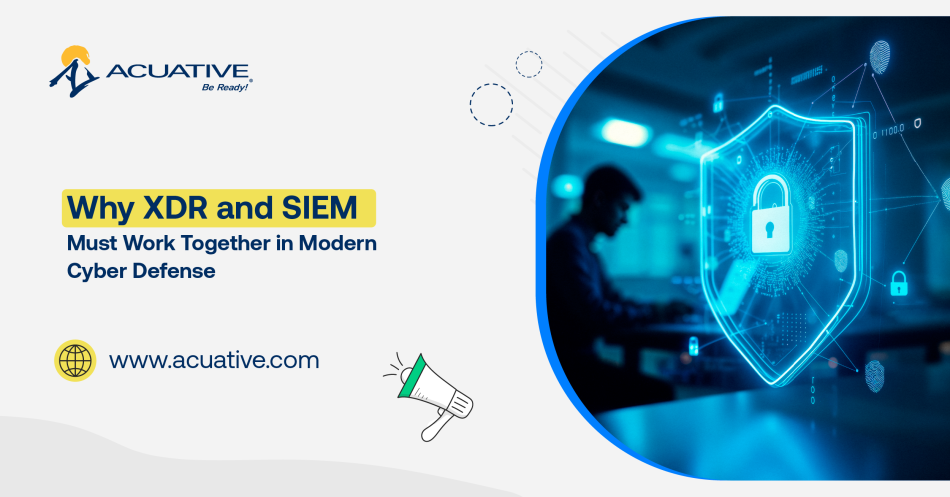Mustafa AbdelRazik
Why One Security Tool Won’t Cut It Anymore
Cybersecurity in 2025 isn’t just about firewalls and antivirus. The game has changed. Threats are faster, more coordinated, and sneakier than ever. And if you’re still relying on one tool to keep up you’re already behind.
Modern security needs a modern strategy. That’s where XDR (Extended Detection and Response) and SIEM (Security Information and Event Management) come in. Separately, they’re powerful. Together? They’re unstoppable.
Let’s break down what they do—and why they’re better together.
XDR vs. SIEM: What’s the Real Difference?
Think of SIEM as your security control tower. It pulls in logs, flags weird behavior, and helps you investigate. It’s great for visibility and compliance. But it’s not always built for speed. XDR is different. It’s like a smart assistant that watches across your endpoints, cloud, network, and more. When it spots something suspicious, it connects the dots fast—and can even shut things down before you’ve had your first coffee.
Here’s what each brings to the table:
SIEM | XDR |
| Centralizes logs from everywhere | Looks deeper into endpoints, identity, cloud, email, and beyond |
| Tracks events across your whole environment | Uses AI to detect subtle threats in real time |
| Supports audits and compliance | Automates response actions |
| Great for investigating after the fact | Built to react, not just report |
Why They’re Stronger Together
If you’re using SIEM without XDR, you’re getting the alerts—but not the action. If you’ve got XDR without SIEM, you’re missing the bigger picture. Together, they give you:
- Total Threat Visibility; SIEM sees wide. XDR sees deepIntegrated, they give you a clear, unified view of what’s happening no blind spots.
- Speed to Respond; SIEM surfaces issues. XDR responds automatically The result? Threats get stopped fast—before they spread.
- Less Noise, More Clarity; SIEM can overload teams with alerts. XDR cuts through the noise with smarter, prioritized insights—so you focus on what matters most.
- Better Compliance and Forensics; SIEM stores and organizes years of logs. XDR adds rich context for deeper investigations. Together, they make audits easier and post-incident analysis faster.
Real Results, Real Fast
This isn’t just theory. Leading security teams are already combining XDR and SIEM to:
- Spot threats in real time
- Automate containment in seconds
- Reduce alert fatigue across SOC teams
- Gain clearer reporting for audits and leadership
Industries Where XDR and SIEM Are Making an Impact
XDR and SIEM aren’t just tools—they’re transforming how entire industries defend against cyber threats. Here’s how they’re delivering real results across key sectors:
- Finance & Banking: Stop fraud faster, monitor compliance in real time, and secure massive transaction volumes without slowing down operations.
- Healthcare: Protect patient records, detect ransomware early, and ensure HIPAA compliance with unified visibility and response.
- Retail & eCommerce: Defend against POS attacks, secure online payment systems, and protect sensitive customer data—all while keeping uptime high.
- Manufacturing & Logistics: Detect operational tech threats before they halt production, secure supply chain communications, and monitor safety-critical systems.
- Telecom & Tech: Monitor vast user traffic, automate incident response, and protect critical infrastructure in high-availability environments.
- Legal & Consulting: Safeguard client data, control document access, and uncover threats fast—without compromising confidentiality or timelines.
Getting Started: A Simple Guide to Launching XDR + SIEM
Not sure where to begin? You’re not alone. Here’s a straightforward way to get your integrated security strategy off the ground:
Step 1: Identify Your Core Security Tools
Take stock of your current SIEM and XDR capabilities. Are they working in silos? Are there blind spots or overlaps?
Step 2: Prioritize the Gaps You Need to Close
Focus on the critical issues your teams face—missed threats, slow response, alert fatigue. These will define your must-have features.
Step 3: Choose the Right Integration Partner
Work with a provider that understands your business, can align with your industry’s compliance needs, and has a proven track record of scalable XDR-SIEM integrations.
Stay Ahead with Acuative
At Acuative, we believe cybersecurity should be connected, intuitive, and ready for tomorrow’s threats. That’s why we help organizations bring together the best of XDR and SIEM—so you can defend smarter, respond faster, and stay resilient. Whether you’re upgrading your existing systems or building a defense strategy from the ground up, we’re here to guide the way. Let’s build a security solution that works for the way your business runs today—and tomorrow.
About Mustafa AbdelRazik

Mostafa Abdelrazik is a skilled Cybersecurity Engineer specializing in protecting systems, applications, and networks from evolving cyber threats. He excels in identifying vulnerabilities, implementing advanced security measures, and ensuring compliance with industry standards.
With expertise in SIEM, EDR, and NDR, Mostafa leverages AI and Machine Learning to detect anomalies, identify patterns, and predict potential threats in real time. By using Elastic Security, he enhances threat detection, incident response, and network visibility, empowering organizations to proactively mitigate cyber risks.
Mostafa is committed to staying up-to-date with the latest cybersecurity trends and developing data-driven security strategies to safeguard infrastructure against cyber-attacks.

